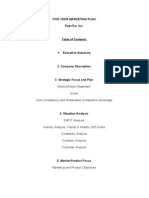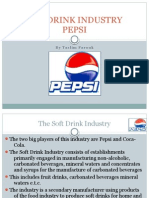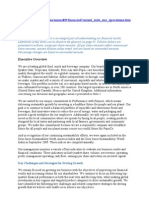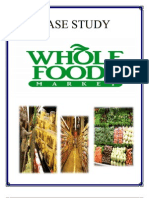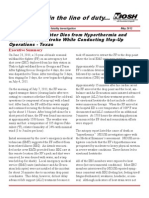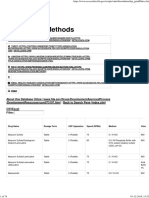0 ratings0% found this document useful (0 votes)
318 viewsAccenture
Accenture
Uploaded by
Priyanka ChowdharyAchieving High Performance
in the Food and Non-alcoholic
Beverage Industry
Copyright:
© All Rights Reserved
Available Formats
Download as PDF, TXT or read online from Scribd
Accenture
Accenture
Uploaded by
Priyanka Chowdhary0 ratings0% found this document useful (0 votes)
318 views12 pagesAchieving High Performance
in the Food and Non-alcoholic
Beverage Industry
Copyright
© © All Rights Reserved
Available Formats
PDF, TXT or read online from Scribd
Share this document
Did you find this document useful?
Is this content inappropriate?
Achieving High Performance
in the Food and Non-alcoholic
Beverage Industry
Copyright:
© All Rights Reserved
Available Formats
Download as PDF, TXT or read online from Scribd
Download as pdf or txt
0 ratings0% found this document useful (0 votes)
318 views12 pagesAccenture
Accenture
Uploaded by
Priyanka ChowdharyAchieving High Performance
in the Food and Non-alcoholic
Beverage Industry
Copyright:
© All Rights Reserved
Available Formats
Download as PDF, TXT or read online from Scribd
Download as pdf or txt
You are on page 1of 12
Page 1
Achieving High Performance
in the Food and Non-alcoholic
Beverage Industry
The US$2 trillion global market for food and non-
alcoholic beverages is complex and highly fragmented.
Just four companies meet Accentures criteria as high-
performance businesses and only two of them have
managed to outperform across all dimensions of our
High Performance Business methodology. Accenture
research suggests that the businesses best positioned to
take the lions share of future value will be characterized
by a clear focus on a limited number of attractive,
innovation-sensitive categories and niches. High
performers will seek to dominate these categories
by being the rst to spot nascent consumer trends,
rapidly and continuously innovating against them and
rigorously focusing their marketing spend on their most
successful products and brands.
Despite its maturity, the Food and
Non-alcoholic Beverage industrys
fragmentationcomprised of more
than 30 distinct product categories
inhibits consolidation. Deal activity
has picked up recently as more
companies have sought focus by trying
to unravel diverse and undifferentiated
portfolios. However, the top 20 players
still account for less than a quarter of
a global market characterized by vast
differences in local taste, perishability
issues and varying food technologies.
Moreover, most of these producers are
struggling to sustain margins.
Rates of growth and protability,
nevertheless, vary signicantly
across individual food and beverage
categories. Sales growth of bottled
water far outstrips that of carbonates,
for example. And ready-made meals
sell almost twice as fast as pasta.
Such differences reect rapidly
evolving patterns of consumer demand
a reection, in turn, of profound
changes in demography and lifestyle.
More women in the workforce and
increased urbanization have fueled
worldwide demand for convenience
foods. At the same time, obesity rates
and food-related diseases like diabetes
have skyrocketed, powering a parallel
desire for healthy and organic
food. In fact, as consumers have
become wealthier, more informed
and thus more condent, eating
for pleasure has caught on in many
countries, cultivating more exotic,
ethnic tastes.
There are, to be sure, signicant
differences globally in these
megatrends. Interest in healthy
nutrition rises in line with disposable
income, while convenience
consumption depends on both income
and the sophistication of local retail
networks. Emerging markets offer
sizeable growth opportunities, if only
because of their relatively low per
capita consumption rates. However,
the bulk of absolute future growth will
come from North America, Western
Europe and Asia Pacic where the
three types of megatrend demands
convenience, health and indulgence
are strongest.
High-performance
businesses position
themselves to
take advantage of
megatrends shaping
the competitive
environment.
Page 2
Page 3
115
28
52
41
24
88
1366
295
124
474
362
334
1549
150
510
321
CAGR
2004-2009
World
Africa and
Middle East
Australasia
Asia Pacific
Latin America
North America
Eastern Europe
WesternEurope
1.5%
5.5%
2.4%
3.8%
2.5%
2.9%
4.8%
2.5%
CAGR
2004-2009
Forecast Sales Growth for Packaged Food, 2004-2009
Forecast Sales Growth for Non-alcoholic Beverages, 2004-2009
2004 (US$ billions) ) 2009 (US$ billions
33
9
44
35
8
25
593
139
57
179
174
174
720
76
210
149
5.0%
2.0%
4.6%
5.8%
3.0%
5.7%
3.2%
3.9%
t
World
Africa and
Middle East
Australasia
Asia Pacific
Latin America
North America
Eastern Europe
WesternEurope
Non-alcoholic Beverages
Packaged Food
Source: Euromonitor, The World Market for Packaged Food, June 2005
Sources: Euromonitor, The World Market for Soft Drinks, Nov 2005, The World Market for Hot Drinks, Feb 2006
Page 4
Each organization in our peer set of
13 publicly quoted companies boasted
global sales of more than US$5 billion
annually. In addition, these companies
all derived at least 75 percent of their
sales from food and non-alcoholic
beverages and 30 percent of these
sales were outside their home regions.
All provided branded packaged
products (rather than food or beverage
ingredients). The three companies that
emerged from our analysis as high-
performance businesses all distinguish
themselves on measures of revenue
growth, protability, return on capital
and working capital management.
They also deliver superior economic
prot, which has allowed them to
deliver consistently superior returns
to shareholdersmore than double
the industry average over the past
ve years. More importantly, their
returns on invested capital consistently
outstrip those of their competitors,
thanks both to higher margins and a
higher percentage of sales per invested
capital in each of the last three years.
Indeed, high-performance businesses
have grown nearly twice as fast as the
industry average by focusing on high-
growth categories and implementing
selective acquisitions to round out their
portfolios and extend channel and
geographic reach. However, only two
companies have consistently delivered
superior returns to shareholders over
both long and short time frames, as
well as superior revenue growth and
protability, and high future value
expectations.
Strategic Market Domination
Rigorous portfolio management focused on winning in high value/high potential markets
Flexible and
Low-cost Operations
Low-cost and exible
duplication enables
seamless execution
Insight-driven
Marketing
Spot it rst, renovate
and innovate, faster
and better execution
Customer and
Channel Management
Laser-like focus on key
customers/channels and
ubiquitous product availability
Culture of Continuous Renewal
Highly exible organization that seamlessly executes and embraces operating change
Market Focus
and Position
Performance
Anatomy
Distinctive
Capabilities
The Building Blocks
of High Performance
in the Food and
Non-alcoholic
Beverage Industry
Accenture denes a high-
performance business as one that
consistently outperforms its peers
through economic and industry
cycles, and through changes in
leadership.
Our extensive cross-industry
research has identied three
building blocks that underpin
high performance in any industry
and that all such businesses have
mastered.
Our industry-specic research has
identied the characteristics that
high performers have in common
across the three building blocks.
Key Trends
High performers have delivered
consistently strong revenue growth.
Acquisitions have proven an important
source of new revenues for many
companies.
The weakest performers have
underperformed due to large, diverse
and undifferentiated portfolios.
5-Year Average
Revenue Growth
Average 5.8%
8.7%
4.3%
2.1%
High
Performers
High Performers
Average Performers
Weak Performers
Sources: S&P, Accenture Analysis
Average
Performers
Weaker
Performers
Page 5
The industrys complexity has led to the evolution of very different
organizational models. Many food and beverage companies are still
organized along local/regional lines, with a presence in only a limited
number of categories, often with a short shelf life. Some have taken a
global, multi-category approach, remaining highly diversied in many
different categories but with a small number of truly global brands.
Only the high-performance businesses have become successful
category specialists, with a presence across most geographies but
with a limited portfolio, tightly focused on a handful of categories
and power brands. This strategic category domination is key to their
status as high-performance businesses. While their peers battle to
build brand share and the struggle for shelf space intensies,
high-performance businesses have successfully leveraged their key
brands, targeting categories with low private-label penetration
and the potential to increase both frequency of purchase and the
amount consumed.
Market Focus and Position
Page 6
Leading companies have consistently
focused on building number 1 and 2
positions in a limited number of high-
growth, high-margin categories or
niches. Wrigley, for example, connes
itself to the confectionery category.
And although PepsiCo plays across
numerous soft drink categories, its
food presence is limited to a small
global portfolio of snacks whose
avors and packaging are adjusted to
accommodate local tastesa natural t
with its carbonates portfolio.
Such businesses achieve category
domination with a selective approach
to acquisitions, which concentrates
on reducing portfolio complexity
while increasing category domination,
distribution power and geographic
reach. Witness PepsiCos recent
acquisitions of Quaker Oats and South
Beach Beverages (SoBe), which sought
to either gain entry into or reinforce
the companys dominance in attractive
fast-growing categories. The Quaker
Oats acquisition, which included
Gatorade, was designed to bolster a
march on Coca-Cola in the energy
drinks category, and SoBe reinforced
PepsiCos position in premium specialty
juices. Both brands are fast-growing,
high-margin categories in line with
the health trend helping to counter-
balance Pepsis traditional carbonates
portfolio.
Many companies, by contrast, still
operate a global, multi-category
model, which dramatically increases
their exposure to business complexity
and thus inhibits growth. One company
has a presence across more than a
dozen separate categories of food,
soft and hot drinks; another has an
even more diverse product portfolio
that includes a large number of
local, often non-scaleable and
undifferentiated brands.
The strategic category
message, however, is
clearly catching on.
Danone, for example,
has been systematically
disposing of non-core
businesses while
refocusing its portfolio
to concentrate on
higher growth regional
opportunities and on
health-conscious
products like pro-biotic
yogurt, where it now
leads the market. Indeed,
Danone now enjoys its
strongest revenue growth
in a decade.
Pasta 3%
Sauces 5%
Glass Containers 7%
Beer 8%
Prepared Foods 9%
Italian Cheeses 9%
Water 10%
Biscuits 20%
Fresh Dairy 29%
Beverages 27%
Biscuits 18%
Fresh Dairy 55%
Sales Split by Category, 2005 Sales Split by Category, 1995
Ten years ago, Danone was an unfocused
food conglomerate.
Danone now enjoys the strongest revenue
growth in a decade.
Following a lengthy spell of portfolio consolidation and disposals, Danone is now
posting the highest organic growth rates for a decade.
Sources: Danone annual reports and Accenture analysis
Page 7
High-performance businesses in this industry display three
distinctive capabilities that set them apart from their peers and
are very difcult to replicate:
Insight-driven marketing
Customer and channel management
Flexible and low-cost operations
Distinctive Capabilities
Page 8
None of these capabilities would be
as effective if they did not also rest on
the exceptionally robust performance
foundations that distinguish high-
performance businessesthe sales
and marketing, supply chain, nance,
IT and HR functions that comprise a
t-for-purpose business infrastructure.
Moreover, all three capabilities work
together to make high performance
possible.
Insight-driven marketing, for
example, supports superior customer
and channel management, and both
depend on the exible and low-cost
operations that enable seamless
execution. The industrys maturity,
however, means that most leading
companies operate pockets of
excellence. Wrigleys success, for
example, is partly due to being
category-advantagedthe company
is focused almost exclusively on
confectionery, especially chewing gum.
Insight-driven marketing
hinges on the ability
to spot trends rst,
before the competition.
High-performance
businesses can do this
because of their superior
understanding of both
market dynamics and
consumer needs.
These companies relentlessly track
key consumer trends in strategic
geographies by means of exceptionally
rigorous, sophisticated and fact-based
business analytics that deliver relevant
and insightful data. They then use the
data to manage systematically the
insights they have gainednot just to
manage information. Whats more,
they make these insights accessible
right across the organization to
facilitate rapid and well-informed
decision-making.
There is no direct correlation in
this industry between the size of
R&D spend and high performance.
Instead, high-performance businesses
distinguish themselves by rapidly
capitalizing on consumer insight to
deliver a continuous ow of new
products to market. Leading companies
tend to have strong new product
pipelines to continuously refresh their
portfolios. They also derive a large
proportion of sales from products
launched in the last three years.
Innovations are often incremental,
rather than spectacular, science-driven
or breakthrough in nature. But the
continuous refreshment of a companys
product portfolio is absolutely vital
to the retention of consumer interest
and maintenance of retail shelf
space. These refreshments include
line extensions, repackaging and
reformulations, as well as genuinely
new products. Overall, incremental
product innovation accounts for most
of this mix and plays a critical role.
Wrigley, for example, launches fewer
than 50 new products a year, but
most of these are line extensions or
new avors. However, by upgrading
its R&D capabilities and restructuring
its marketing team to focus on global
brands and excellent local execution,
the company has capitalized on its
unied commercial operations and
centralized supply chain to consistently
deliver innovation rates above 15
percent every year since 2000.
Leading businesses support their
innovation capabilities by spending a
higher proportion of sales than their
peers on clever, innovative marketing,
and revitalizing brands through
advertising and promotions. Take,
for example, PepsiCos repositioning
of its portfolio on a better-for-you
platform through the Smart Spot
TM
initiative. (The campaign is currently
conned to North America but
is earmarked for global roll-out.)
Smart Spot consolidated 100 of
the companys healthier products,
including the Tropicana range of fruit
juices. Half of the companys media
spend is now devoted to Smart Spot.
Not all attempts to capitalize on the
health and wellness trend have been
successful. One food giants efforts to
reformulate hundreds of products in
nutritional terms was compromised by
its product portfolio, which included
too many diverse categories.
Page 9
Performance Anatomy
Performance anatomy, like distinctive capabilities, rests on foundation functions,
but it also describes a companys mindset. In the Food and Non-alcoholic Beverage
industry, performance anatomy describes a unique adaptability. High-performance
businesses in this industry are just much better at cooperating with their suppliers
and customers than their competitors and their peers in related sectors such as
alcoholic beverages and personal care.
Operating margins are lower than in related industriesa function of a relatively
short product shelf life. So whether they like it or not, Food and Non-alcoholic
Beverage companies are very dependent on external relationships and need to be
tightly networked. High-performance businesses are especially good at third-party
manufacturing, distribution and low-cost sourcing; their relative dependence
on their retail customers also has led to close and highly successful working
relationships. Some actually have integrated their supply chains with those of
their customers, who run Collaborative Planning Forecasting & Replenishment
(CPFR) for them.
Packaged food and beverages
companies must also contend
with both the growing power of
supermarkets and the private label
penetration that this power reinforces.
They also face the challenge of a
multi-channel selling environment as
the share of sales through alternative
channels like kiosks and vending
machines steadily increases. Indeed,
customer and channel management
is critically important. And leading
companies exhibit a laser-like focus on
key customers and channels.
Witness Kelloggs purchase of Keebler,
whose cookies and crackers are
available in vending machines across
the United States. The acquisition not
only gave Kelloggs critical mass in US
snacks, it also allowed the company to
distribute its own Pop-Tarts, Nutri-
Grain bars and packaged cereals
through many more channels, greatly
extending its customer reach.
Simply boosting expenditure on trade
promotions does not guarantee better
returns, so high-performance businesses
go further. Not only do they employ
integrated commercial planning to
maximize the effectiveness of trade
investments; they also use sophisticated
analytics to evaluate the performance
of past promotions and include the
results in the next round of promotional
planningall with an execution mindset
worthy of a nancial fund manager.
Of course, without exible and low-
cost operations high-performance
businesses would not be able to
sustain excellence in their other
distinctive capabilities. High
performance is getting harder to
achieve as soaring commodity
prices and other cost pressures
squeeze margins, while the growth
of emerging markets extends and
globalizes supply chains.
So leading businesses focus on
streamlining and leveraging economies
of scale in all key areas of their supply
chain, from long-term commodity
planning to outsourcing. Thus, they
create a global operations footprint,
increase collaboration with both
customers and suppliers, and seek to
relentlessly drive out costs. PepsiCo,
for example, has cushioned itself from
the impact of rising aluminum prices
by halving the aluminum content in its
packaging since 2001. PepsiCo, Wrigley
and Kelloggs, moreover, use nancial
hedging to try and manage the prices
of their key commodities. And all three
companies have dramatically upgraded
their technology infrastructures (and
thus their operational efciency) with
global ERP roll-outs.
Page 10
Page 11
High-performance businesses have
turned category focus, incremental
innovation, targeted marketing and
R&D investment and ruthless cost
control into a continuous cycle to
deliver long-term shareholder value.
They have achieved this advantageous
position by means of rigorous portfolio
management and by developing a
highly exible organization with
three distinctive capabilities that
enable them to seamlessly embrace
and execute.
The Future
However, there are many challenges
to the industrys future value. While
consolidation continues, it is likely to
be very gradual, as long as local taste
and shelf-life issues limit economies
of scale and most producers still juggle
with the complexity of managing a
diverse and often locally customized
brand portfolio.
Accenture research suggests that
the key to capturing future growth
opportunities will remain a relentless
focus on premium product categories:
foods and drinks that satisfy at least
two of the three megatrend demands
(convenience, health and indulgence)
and ideally all of them. Indeed, the
high-performance businesses of the
future will stand above their peers as
a result of their ability to exploit the
megatrendsfor fast and efcient
nutrition, guilt-free indulgence and
quality convenience.
Efcient Nutrition
(Fast but nutritious and healthy)
Health & Wellness
More information & labeling
More evidence for health claims
More control through food plus
food minus and natural/organic
alternatives
The Time Factor
More individual (portion) control
More control over time and quality
of preparation
Convenient packaging/channels
Convenience Plus
(Convenience with from scratch
quality and entertainment)
The Sensory Experience
More premium & indulgent
More ethnic & exotic tastes
Guilt-free Indulgence
(Low & light without compromising)
Signicant growth opportunities for products that deliver against hot spots
which satisfy two or more key consumer trends
Indulgence
Convenience
Health
Page 12
Copyright 2007 Accenture
All rights reserved.
Accenture, its logo, and
High Performance Delivered
are trademarks of Accenture.
This document makes reference to
trademarks that may be owned by
others. The use of such trademarks
herein is not an assertion of ownership
of such trademarks by Accenture
and is not intended to represent or
imply the existence of an association
between Accenture and the lawful
owners of such trademarks.
To nd out more about how companies
in the Food and Non-alcoholic
Beverage industry can achieve high
performance, please contact:
Keith Barringer
Managing Director,
Consumer Goods and Services
+44 207 844 4600
c.keith.barringer@accenture.com
John Jackson
Europe
+44 20 7844 2779
john.jackson@accenture.com
Fabio Vacirca
Europe
+39 27 7758 483
fabio.vacirca@accenture.com
Greg Supron
North America
+1 973 301 1681
gregory.j.supron@accenture.com
Apolonia Kersch
Asia Pacic
+61 29 005 5355
apolonia.kersch@accenture.com
Silvio Barboza
Latin America
+55 115 188 3185
silvio.l.barboza@accenture.com
About Accenture
Accenture is a global management
consulting, technology services and
outsourcing company. Committed to
delivering innovation, Accenture col-
laborates with its clients to help them
become high-performance businesses
and governments. With deep industry
and business process expertise, broad
global resources and a proven track
record, Accenture can mobilize the right
people, skills and technologies to help
clients improve their performance. With
approximately 170,000 people in 49
countries, the company generated net
revenues of US$19.70 billion for the s-
cal year ended Aug. 31, 2007. Its home
page is www.accenture.com.
You might also like
- Matter For EnvironmentDocument9 pagesMatter For EnvironmentMohammad Yusuf NabeelNo ratings yet
- PEPSICO Diversification StrategyDocument36 pagesPEPSICO Diversification StrategyWyman Kemp100% (4)
- Edited Presentation FINAL COPY - Whole FoodsDocument46 pagesEdited Presentation FINAL COPY - Whole FoodsShahriar AlamNo ratings yet
- Serge Iraguha - Industry AnalysisDocument9 pagesSerge Iraguha - Industry AnalysisSerge IraguhaNo ratings yet
- Pepsi - Co Diversification Strategy Case AnalysisDocument36 pagesPepsi - Co Diversification Strategy Case AnalysisErri Wibowo100% (5)
- Case Study of BeveragesDocument31 pagesCase Study of BeveragesSyiera Fella's100% (2)
- Marketing AssingmentDocument8 pagesMarketing AssingmentSonia MusoroNo ratings yet
- Industry Analysis and Trends in The Industry and Consumers' BehaviorDocument2 pagesIndustry Analysis and Trends in The Industry and Consumers' BehaviorAnonymous kySFSuNo ratings yet
- Assignment 2: Student Number 1710D3613374Document9 pagesAssignment 2: Student Number 1710D3613374Aaron Iron Tsaka100% (1)
- FOOD AND BEVERAGES Porters Pestel & Industry TrendsDocument8 pagesFOOD AND BEVERAGES Porters Pestel & Industry TrendsGreeshma SharathNo ratings yet
- Eyeon WP Forecasting Planning in The Food IndustryDocument12 pagesEyeon WP Forecasting Planning in The Food IndustryAlok KumarNo ratings yet
- Dr. Pepper Snapple GroupDocument14 pagesDr. Pepper Snapple GroupAngeline Paguirigan Dionicio100% (1)
- SWOT Analysis of Coca ColaDocument6 pagesSWOT Analysis of Coca ColaLhayne PoncianoNo ratings yet
- Beverage Industry Report-FINAL 20110907Document104 pagesBeverage Industry Report-FINAL 20110907Aakash ChhariaNo ratings yet
- Competition in Energy Drinks by Dwitya Arbawa Gadjah Mada University MM UGMDocument3 pagesCompetition in Energy Drinks by Dwitya Arbawa Gadjah Mada University MM UGMDwitya AribawaNo ratings yet
- Whole Foods Market Acquisition by AmazonDocument2 pagesWhole Foods Market Acquisition by AmazonTharindu Dasun WeerasingheNo ratings yet
- PEST Soft Drinks IndustryDocument16 pagesPEST Soft Drinks Industryannekaren23No ratings yet
- Anumita Mitra Bms3a PDFDocument7 pagesAnumita Mitra Bms3a PDFHbNo ratings yet
- SoftDrinkIndustryMarketing 11Document104 pagesSoftDrinkIndustryMarketing 11Bill M.No ratings yet
- My Internship Report FullDocument56 pagesMy Internship Report FullSarah_Razzah_4343100% (2)
- MIT15 768F10 Paper05 PDFDocument19 pagesMIT15 768F10 Paper05 PDFVINITHANo ratings yet
- Mktm674 Ca1Document13 pagesMktm674 Ca1Faisal NaikNo ratings yet
- Case StudyDocument11 pagesCase StudyShakti Shivanand0% (1)
- Food Retail Industry Insights 2016 PDFDocument11 pagesFood Retail Industry Insights 2016 PDFDuc BeoNo ratings yet
- Case 2 - Competition in Energy DrinksDocument3 pagesCase 2 - Competition in Energy DrinksSheena GabrielaNo ratings yet
- Report On PepsiDocument25 pagesReport On Pepsisinjin666100% (1)
- Whole Foods Market Inc. SWOT AnalysisDocument9 pagesWhole Foods Market Inc. SWOT AnalysisAlbertWhatmough100% (1)
- Business Insights: The Top 10 Global Leaders in FoodDocument8 pagesBusiness Insights: The Top 10 Global Leaders in Foodprofiler444No ratings yet
- Pepsico Swot AnalysisDocument4 pagesPepsico Swot AnalysisAhmed Bux Dayo100% (1)
- 3a Case StudyDocument17 pages3a Case StudyJudy Ann SorianoNo ratings yet
- Soft Drink Industry PepsiDocument33 pagesSoft Drink Industry PepsiPhoenix VantiatusNo ratings yet
- Soft DrinksDocument7 pagesSoft DrinksShubam SharmaNo ratings yet
- Pratt Center Food Distribution Study August 2013 1Document18 pagesPratt Center Food Distribution Study August 2013 1JDNo ratings yet
- Aira May P. Adriaga BSTM 3-ADocument13 pagesAira May P. Adriaga BSTM 3-ADaniel LamasonNo ratings yet
- Ur Business: Key Challenges and Strategies For Driving GrowthDocument8 pagesUr Business: Key Challenges and Strategies For Driving Growthkhullg01No ratings yet
- 1-Competition in Energy Drinks, Sports Drinks and Vitamin Enhanced Beverages (English)Document8 pages1-Competition in Energy Drinks, Sports Drinks and Vitamin Enhanced Beverages (English)Deru R IndikaNo ratings yet
- Strategic Recommendation For New EntrantDocument11 pagesStrategic Recommendation For New EntrantEkta AroraNo ratings yet
- Whole Food MARKET1Document28 pagesWhole Food MARKET1Keepllng Mananya HrzNo ratings yet
- Final PPT STMDocument30 pagesFinal PPT STMqaziamadNo ratings yet
- Coca ColaDocument12 pagesCoca Coladelphine lugaliaNo ratings yet
- Organic Valley (Marketing)Document15 pagesOrganic Valley (Marketing)Kunal GudhkaNo ratings yet
- Swot Analysis of PEPSI CoDocument6 pagesSwot Analysis of PEPSI CoJawad MalikNo ratings yet
- Case Study 2 Whole Foods Market Group 4Document17 pagesCase Study 2 Whole Foods Market Group 4renjionlinNo ratings yet
- Pepsi - Value Chain, Strategic Planning, Decision PlanningDocument11 pagesPepsi - Value Chain, Strategic Planning, Decision PlanningSwagat LenkaNo ratings yet
- Whole FoodDocument18 pagesWhole FoodAhad Alim100% (1)
- Competitive Forces and SWOT Analysis of Whole Foods MarketDocument6 pagesCompetitive Forces and SWOT Analysis of Whole Foods MarketsksinghicfaiNo ratings yet
- Swot N Pest Analysis of Nestle and Coca ColaDocument4 pagesSwot N Pest Analysis of Nestle and Coca Colad-fbuser-18320266100% (2)
- PepsicoDocument9 pagesPepsicoCalvi JamesNo ratings yet
- CocaCola Case StudyDocument20 pagesCocaCola Case StudyEirikLetnesNo ratings yet
- Food for a Better Future: A new direction for the global business of foodFrom EverandFood for a Better Future: A new direction for the global business of foodNo ratings yet
- The Food Truck Handbook: Start, Grow, and Succeed in the Mobile Food BusinessFrom EverandThe Food Truck Handbook: Start, Grow, and Succeed in the Mobile Food BusinessRating: 5 out of 5 stars5/5 (1)
- The Grocery Store Bible: A Beginner's Guide To Understanding And Running A Grocery Store SuccessfullyFrom EverandThe Grocery Store Bible: A Beginner's Guide To Understanding And Running A Grocery Store SuccessfullyNo ratings yet
- What Were They Thinking? (Review and Analysis of McMath and Forbes' Book)From EverandWhat Were They Thinking? (Review and Analysis of McMath and Forbes' Book)No ratings yet
- Trading Up (Review and Analysis of Silverstein and Fiske's Book)From EverandTrading Up (Review and Analysis of Silverstein and Fiske's Book)No ratings yet
- Beyond the Familiar: Long-Term Growth through Customer Focus and InnovationFrom EverandBeyond the Familiar: Long-Term Growth through Customer Focus and InnovationNo ratings yet
- NIOSH Investigation - CR 337 Fire LODDDocument32 pagesNIOSH Investigation - CR 337 Fire LODDRamblingChiefNo ratings yet
- Ethical DMDocument17 pagesEthical DMmasterstar13No ratings yet
- A Guide To Rational LivingDocument23 pagesA Guide To Rational LivingJerome BrusasNo ratings yet
- Activating American Investment Overseas For A Freer, More Open WorldDocument32 pagesActivating American Investment Overseas For A Freer, More Open WorldThe Wilson CenterNo ratings yet
- Dissolution MethodsDocument74 pagesDissolution MethodsDilawar Bakht0% (2)
- Take Control of Your Health and Escape The Sickness IndustryDocument348 pagesTake Control of Your Health and Escape The Sickness IndustryCarlos Chafla100% (1)
- Pediatric Red Ear Syndrome: A Case Report of An Erythromelalgia Type and Review of The LiteratureDocument4 pagesPediatric Red Ear Syndrome: A Case Report of An Erythromelalgia Type and Review of The LiteraturedanniwebbNo ratings yet
- TheophyllineDocument27 pagesTheophyllineAci LusianaNo ratings yet
- National Action Plan Ncds PakistanDocument162 pagesNational Action Plan Ncds PakistanNaseem QaziNo ratings yet
- Parsons Contempt OrderDocument4 pagesParsons Contempt OrderJimmy JenkinsNo ratings yet
- Tidy's PhysiotherapyDocument10 pagesTidy's PhysiotherapyRoopa RaniNo ratings yet
- MSDS - Silicon Sealant AA-288Document6 pagesMSDS - Silicon Sealant AA-288Muhammad ShofiudinNo ratings yet
- Case of Cerebellar Ataxia and TremorsDocument2 pagesCase of Cerebellar Ataxia and TremorsBacean Aurel IoanNo ratings yet
- Health Is WealthDocument1 pageHealth Is Wealthriana safrianiNo ratings yet
- Veterinary Medicine VolumeDocument54 pagesVeterinary Medicine VolumeRoll 17 Anjali HembramNo ratings yet
- Different Types of Meat and Its SourcesDocument6 pagesDifferent Types of Meat and Its SourcesJeric Enteria Cantillana67% (3)
- GRADES 1 To 12 Daily Lesson Log: School: Grade Level: Teacher: Learning Area: Teaching Dates and Time: QuarterDocument27 pagesGRADES 1 To 12 Daily Lesson Log: School: Grade Level: Teacher: Learning Area: Teaching Dates and Time: Quartermark daveNo ratings yet
- Lab Policies Cobas C311 Routine Operation Lab 4014 PDFDocument3 pagesLab Policies Cobas C311 Routine Operation Lab 4014 PDFATUL DESHMUKH60% (5)
- MARIAMMMDocument11 pagesMARIAMMMHasnain JawedNo ratings yet
- Chronic Prostatitis A Possible Cause of HematospermiaDocument6 pagesChronic Prostatitis A Possible Cause of HematospermiaZlatan ZvizdicNo ratings yet
- Word FormationDocument3 pagesWord FormationTanya ZavyalovaNo ratings yet
- INFECTIONS IN DIALYSIS PATIENTS Basis & Prevention by Dr.T.V.Rao MDDocument48 pagesINFECTIONS IN DIALYSIS PATIENTS Basis & Prevention by Dr.T.V.Rao MDtummalapalli venkateswara rao100% (1)
- Safety Programm of DamDocument80 pagesSafety Programm of DamSigit Bintan100% (1)
- Housemanship Applying ProceduresDocument15 pagesHousemanship Applying ProceduresRebecca BrandonNo ratings yet
- Let Them Drink: Denis Omanovic AJRL 200Z/ Lombardo 4/14/09 1150 Words Enterprise Project DraftDocument4 pagesLet Them Drink: Denis Omanovic AJRL 200Z/ Lombardo 4/14/09 1150 Words Enterprise Project Draftyankeesd13No ratings yet
- Clinical Trials Thesis TopicsDocument4 pagesClinical Trials Thesis Topicsshannonjoyarvada100% (2)
- 10success Affirmations PDFDocument2 pages10success Affirmations PDFCarliveth100% (1)
- Demam Tifoid FTKP Bpjs Hotel ClarionDocument68 pagesDemam Tifoid FTKP Bpjs Hotel ClarionPeriyent Liveryent VozzervodNo ratings yet
- Glu FluitestDocument4 pagesGlu FluitestCristian LaraNo ratings yet
- Pola Makan Dan Asuh - Stunting - RitaDamaDocument37 pagesPola Makan Dan Asuh - Stunting - RitaDamaLifiahNo ratings yet

























